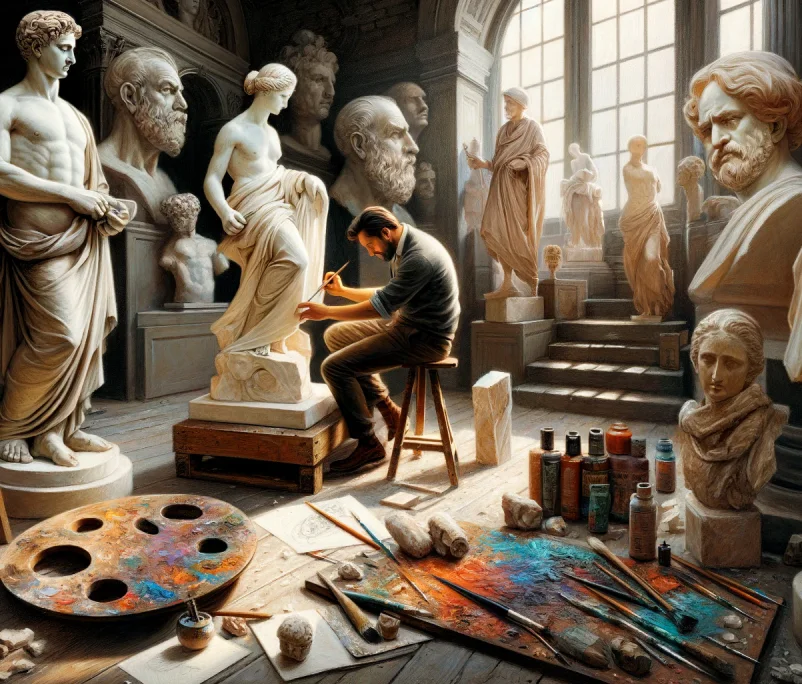Ancient artz beckons us to explore the depths of human creativity and expression from centuries long past. It tells stories of cultures, beliefs, and practices that shaped civilizations. Each piece carries a whisper of history—a reminder of where we came from. Whether it’s a striking mural on an ancient wall or an intricate sculpture carved from stone, ancient artz invites curiosity and admiration.
As we delve into this fascinating world, we’ll uncover the significance behind these works, how they continue to influence modern creativity, and what makes them timeless treasures. Join me on this journey through time as we appreciate the artistry that has survived the ages!
What is Ancient Art?
Ancient artz refers to the creative expressions produced by civilizations long before our time. It encompasses a wide range of mediums, including painting, sculpture, pottery, and textiles. Each piece reflects the unique cultural identities of its creators.
Crafted thousands of years ago, ancient artz serves as a window into the past. From cave paintings in Lascaux to the grand architecture of Ancient Greece, these works often convey spiritual beliefs or depict daily life. They reveal insights about social structures and human experiences.
The materials used were often sourced from local environments: clay for pottery or stone for sculptures. Such choices highlight humanity’s connection with nature at that time.
Ancient artz is more than just aesthetic objects; it’s a rich tapestry woven from history and culture that continues to inspire generations today.
The Importance and Influence of Ancient Art
Ancient art serves as a vital link to our past, offering insights into the lives and cultures of ancient civilizations. Each piece tells a story, revealing beliefs, social structures, and daily activities.
Its influence extends beyond aesthetics; it shapes modern artistic expressions. Contemporary artists often draw inspiration from ancient motifs and techniques. This connection fosters a dialogue between eras.
Moreover, ancient art has the power to unite diverse communities through shared heritage. Museums around the world showcase these treasures, fostering appreciation across different cultures.
In education, studying ancient art enhances critical thinking skills. It encourages students to analyze context and symbolism while cultivating empathy for historical narratives.
The significance of ancient art resonates deeply within society today. Its enduring legacy continues to inspire creativity and innovation in countless forms.
Different Types of Ancient Art
Ancient artz encompasses a wide variety of forms and mediums, showcasing unique cultural expressions across different civilizations.
Sculpture stands out as one of the most enduring types. From the colossal statues of ancient Rome to intricate Greek reliefs, these works capture human emotion and beauty.
Pottery is another fascinating category. Each piece tells a story through its design, color, and functionality. The vibrant patterns on ancient vases provide insights into daily life and mythology.
Wall paintings are equally captivating. Found in tombs or temples, they serve both decorative and spiritual purposes. These murals often depict gods or significant historical events.
Textiles also play a vital role in ancient artz. Fabrics woven with care reveal much about trade practices and social status in various societies.
Each type contributes to our understanding of past cultures while inspiring contemporary artists today.
Examples of Famous Ancient Art Pieces
Ancient artistry boasts remarkable pieces that continue to captivate audiences today. One standout is the intricate Parthenon frieze from Greece, depicting mythological scenes with stunning detail.
In Egypt, the enigmatic mask of Tutankhamun glitters with gold and precious stones. This artifact provides insights into royal life and burial customs over three thousand years ago.
The Terracotta Army in China presents a breathtaking collection of thousands of life-sized soldiers. Each figure reflects unique craftsmanship, symbolizing the power and might of Emperor Qin Shi Huang.
Meanwhile, Mesoamerican cultures gifted us with exquisite Maya stelae. These stone monuments tell stories through elaborate carvings that celebrate rulers and significant events.
These masterpieces not only showcase technical skill but also reveal cultural narratives that have shaped civilizations throughout history. Their continued relevance speaks volumes about humanity’s artistic legacy.
How to Appreciate and Interpret Ancient Art
Appreciating ancient art requires an open mind. Each piece tells a story from another time, inviting viewers to connect with its historical context.
Start by observing the details. Look for colors, materials, and techniques used. These elements can reveal how cultures expressed their beliefs and values through artistry.
Consider the symbolism embedded in the work. Many ancient pieces incorporate motifs that represent life, death, or spirituality. Understanding these symbols adds depth to your interpretation.
Don’t shy away from asking questions. What emotions does this artwork evoke? How does it relate to today’s world? Engaging with these queries enriches your experience and fosters a personal connection.
Visit museums or galleries where experts curate displays thoughtfully. Guided tours often offer insights you might miss on your own, enhancing appreciation further than mere observation allows.
Embrace different perspectives. Discussing art with others opens doors to interpretations you may not have considered before.
Preservation and Restoration of Ancient Art
Preservation and restoration of ancient art are crucial for maintaining our cultural heritage. These processes ensure that future generations can appreciate the beauty and significance of historical works.
Conservation specialists meticulously assess each piece. They identify materials, techniques, and damage levels before deciding on a treatment plan. This scientific approach helps to balance preservation with respect for the original intent of the artist.
Restoration goes beyond mere repair; it often involves recreating lost elements while leaving enough evidence of the artwork’s history. Ethical considerations guide these practices, ensuring transparency about any interventions made.
Innovative technology plays a role as well. Techniques like 3D scanning allow experts to document pieces in detail, capturing their condition at various stages. This data aids in future restorations and research.
Both preservation and restoration require an intimate understanding of art’s context—its time period, culture, and intended message—all vital to keeping ancient artz alive for everyone to enjoy.
Modern Day Applications of Ancient Art Techniques
Modern artists often look to ancient artz for inspiration. Techniques from centuries past breathe new life into contemporary creations. For instance, fresco painting, once a staple in ancient Rome and Greece, is now experiencing a revival among muralists.
Ceramics also benefit from age-old methods. Potters incorporate traditional glazing techniques to create stunning pieces that blend history with modern aesthetics. This fusion brings depth and character to today’s art scene.
Textiles provide another avenue for the application of ancient practices. Weavers experiment with patterns drawn from historical artifacts, creating fabrics that tell stories of their own.
Even digital artists reference principles found in ancient artz. Layering techniques and color palettes are influenced by the rich histories of earlier artworks. By embracing these time-tested methods, today’s creators honor the past while pushing boundaries in innovative ways.
Conclusion
Ancient artz offers a fascinating glimpse into the history and culture of civilizations long gone. It showcases the creativity and skill of artists who used limited resources to express their beliefs, values, and stories. By studying ancient art, we not only appreciate its aesthetic beauty but also gain insights into the lives of our ancestors.
The importance of preserving these works cannot be understated. As custodians of human history, we have a responsibility to protect these artifacts for future generations. Moreover, modern applications inspired by ancient techniques remind us that the past continues to influence contemporary practices in art and design.
Whether you are an avid collector or simply curious about historical cultures, exploring ancient artz can deepen your understanding of humanity’s journey through time. Embracing this rich heritage enriches our present while inspiring visions for tomorrow’s creations.










